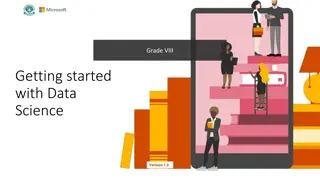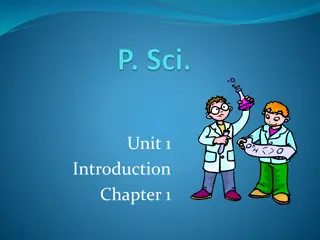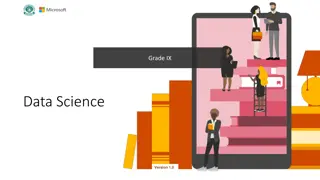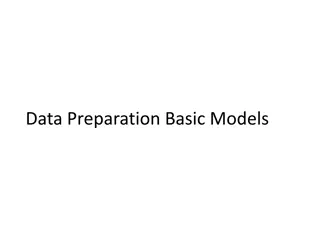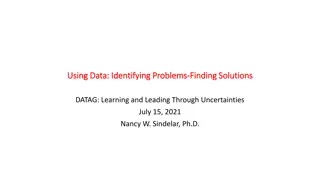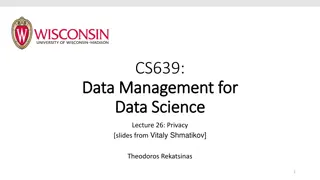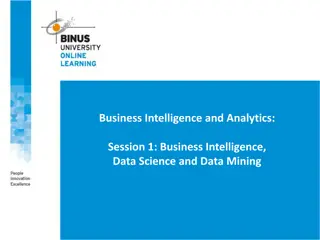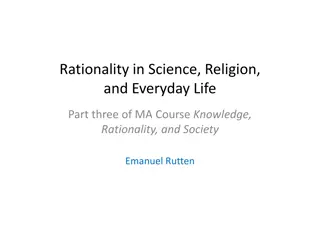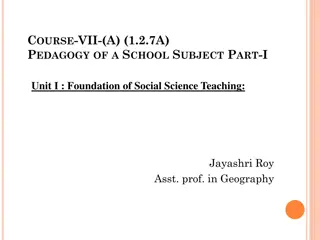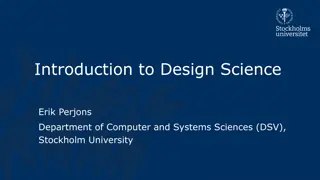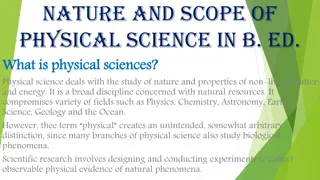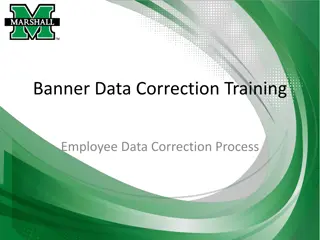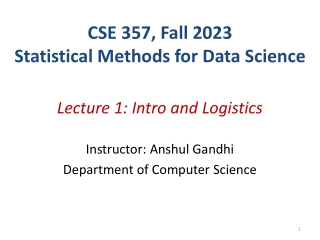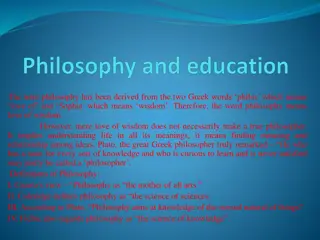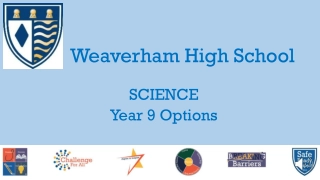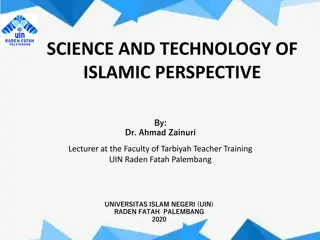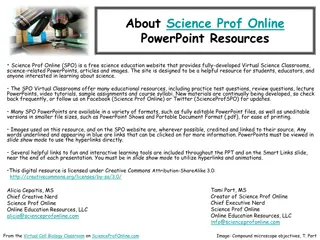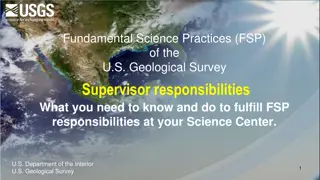Understanding the Essence of Data Science
Data science is a dynamic field blending hacking and statistics to derive insights from vast amounts of data. It involves converting various aspects of life into data, creating new forms of value. The demand for data scientists is surging due to the data explosion and technological advancements. A data science team must align its skills with the data problems at hand for effective problem-solving.
Download Presentation

Please find below an Image/Link to download the presentation.
The content on the website is provided AS IS for your information and personal use only. It may not be sold, licensed, or shared on other websites without obtaining consent from the author. Download presentation by click this link. If you encounter any issues during the download, it is possible that the publisher has removed the file from their server.
E N D
Presentation Transcript
Introduction to Data Science Introduction to Data Science Dr. Kalpakis, Fall 2017 1
What is Data Science? What is Data Science? Data scientists, "The Sexiest Job of the 21st Century" (Davenport and Patil, Harvard Business Review, 2012) Much of the data science explosion is coming from the tech-world What does Data Science mean? Is it the science of Big Data? What is Big Data anyway? Who does Data Science and where? What existed before Data Science came along? Is it simply a rebranding of statistics and machine learning? Anything that has to call itself a science isn t. Hype increases noise-to-signal ratio in perceiving reality and makes it harder to focus on the gems Why and how to hire a data scientist? http://goo.gl/F4K4hE 2
Why now? Why now? massive amounts of data about many aspects of our lives, both online and offline activities, real- time as well as past-time Datafication= taking all aspects of life and turning them into data Once we datafy things, we can transform their purpose and turn the information into new forms of value. abundance of inexpensive computing power, communication capacity proliferation of small footprint low-power sensors (IoT) feedback loop between our behavior, environment, and data products 3
Data Science take I Data Science take I Data science, as it s practiced, is a blend of Red-Bull-fueled hacking and espresso-inspired statistics. But data science is not merely hacking because when hackers finish debugging their Bash one-liners and Pig scripts, few of them care about non- Euclidean distance metrics. And data science is not merely statistics, because when statisticians finish theorizing the perfect model, few could read a tab-delimited file into R if their job depended on it. Data science is the civil engineering of data. Its acolytes possess a practical knowledge of tools and materials, coupled with a theoretical understanding of what s possible. Drew Conway s Venn diagram of data science Mike Driscoll (CEO of Metamarket) Many posers It s not enough to just know how to run a black box algorithm. You actually need to know how and why it works, so that when it doesn t work, you can adjust. Cathy O Neil 4
Data Science team Data Science team individual data scientist profiles are merged to make a Data science team team profile should align with the profile of the data problems to tackle 5
Data science: skills and actors Data science: skills and actors Clustering and visualization of data science subfields based on a survey of data science practitioners (Analyzing the Analyzers by Harlan Harris, Sean Murphy, and Marck Vaisman, 2012) Data Businesspeople are the product and profit-focused data scientists. They re leaders, managers, and entrepreneurs, but with a technical bent. A common educational path is an engineering degree paired with an MBA. Data Creatives are eclectic jacks-of-all-trades, able to work with a broad range of data and tools. They may think of themselves as artists or hackers, and excel at visualization and open source technologies. Data Developers are focused on writing software to do analytic, statistical, and machine learning tasks, often in production environments. They often have computer science degrees, and often work with so-called big data . Data Researchers apply their scientific training, and the tools and techniques they learned in academia, to organizational data. They may have PhDs, and their creative applications of mathematical tools yields valuable insights and products. 6
Types of Data Scientists Types of Data Scientists Machine Learning Scientist Statistician Software Programming Analyst Data Engineer Actuarial Scientist Business Analytic Practitioner Quality Analyst Spatial Data Scientist Mathematician Digital Analytic Consultant 7
What do data scientists do? What do data scientists do? define what data science is by what data scientists get paid to do (O Neil and Schutt) In academia, a data scientist is trained in some discipline, works with large amounts of data, grapples with computational problems posed by the structure, size, messiness, and the complexity and nature of the data, and solves real-world problems. In industry, a data scientist knows how to extract meaning from and interpret data, which requires both tools and methods from statistics and machine learning, as well as being human. spends a lots of effort in collecting, cleaning, and munging data utilizing statistics and software engineering skills. performs exploratory data analysis, finds patterns, builds models, and algorithms. communicates the findings in clear language and with data visualizations so that even if her/his colleagues unfamiliar with the data can understand the implications 8
Data Science take II Data Science take II Data science, also known as data-driven science, is an interdisciplinary field about scientific methods, processes, and systems to extract knowledge or insights from data in various forms, either structured or unstructured,similar to data mining. (Wikipedia) The 4th paradigm of science (theoretical, empirical, computational, and data-driven) (Jim Gray) 9
Data Science Process Data Science Process CRISP-DM (Cross Industry Standard Process for Data Mining) Data science process flowchart (O Neil and Schutt) 10
CRISP-DM Phases, tasks, outputs Business Understanding Data Data Modeling Evaluation Deployment Understanding Preparation Determine Business Objectives Background Business Objectives Business Success Criteria Collect Initial Data Initial Data Collection Report Data Set Data Set Description Select Modeling Technique Modeling Technique Modeling Assumptions Evaluate Results Assessment of Data Mining Results w.r.t. Business Success Criteria Approved Models Plan Deployment Deployment Plan Situation Assessment Inventory of Resources Requirements,Assumptions, and Constraints Risks and Contingencies Terminology Costs and Benefits Describe Data Data Description Report Select Data Rationale for Inclusion / Exclusion Generate Test Design Test Design Review Process Review of Process Plan Monitoring and Maintenance Monitoring & Maintenance Plan Determine Data Mining Goal Data Mining Goals Data Mining Success Criteria Explore Data Data Exploration Report Clean Data Data Cleaning Report Build Model Parameter Settings Models Model Description Determine Next Steps List of Possible Actions Decision Produce Final Report Final Report Final Presentation Produce Project Plan Project Plan Initial Asessment of Tools and Techniques Verify Data Quality Data Quality Report Construct Data Derived Attributes Generated Records Assess Model Model Assessment Revised Parameter Settings Review Project Experience Documentation Integrate Data Merged Data Format Data Reformatted Data 11


